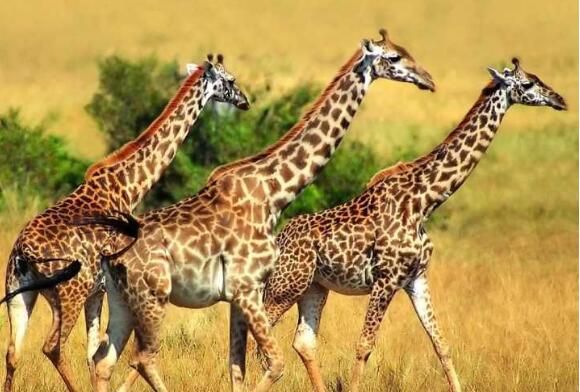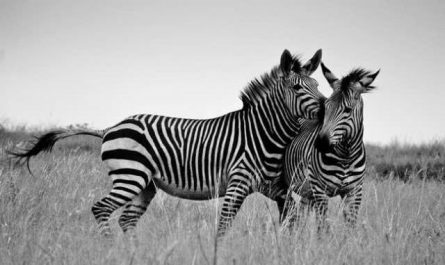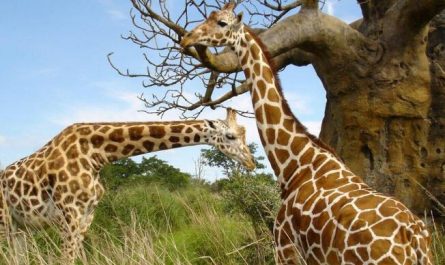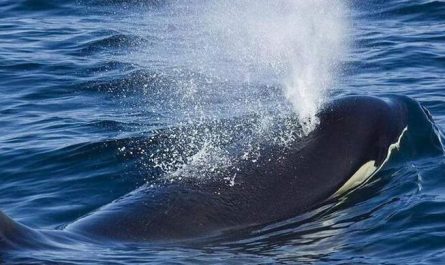The reason why giraffe’s neck is particularly long
The giraffe is the tallest land animal in the world. Someone once measured a very large giraffe, reaching nearly 6 meters in height. The giraffe has a strange appearance and an elegant posture. It is very alert and extremely flexible. The protruding eyes on the head can observe the surrounding conditions at the same time. The four long legs support a body weighing nearly a ton. It can run at a speed of 60 kilometers per hour. In the forests at the junction of grasslands and forests in Africa, you can see them chewing on leaves.
In the early stages of ancient evolution, the body of a giraffe was only the size of a fawn, and it was active on the continents of Europe, Asia, and Africa. As the earth changes, the living area of giraffes is gradually concentrated in a few areas in eastern Africa. When biologists studied the evolution of giraffes, they believed that the ancestors of giraffes had fed on grass for generations. But when suffering from drought and other disasters, large tracts of grassland are deserted. In order to survive, giraffes must always stretch their necks and eat the tender leaves of the trees. The giraffes with short necks cannot eat the tender leaves of the trees. The land is eliminated by natural conditions. In this way, after many generations, the neck slowly grew longer, and finally formed the current appearance.
The giraffe’s long neck is essential for guarding sentries, understanding the enemy’s situation and seeking food, and it is also an effective cooling tower. Relying on its neck to dissipate heat, it can adapt to tropical heat. When moving forward, the long neck of a giraffe can also be used to increase power. When walking or running, the head is placed in front, and its center of gravity is moved forward.
At present, the total number of giraffes in the world is about 450,000. The giraffe has a unique body and posture, no other animal can compare with it, so it is loved by people. Zoologists believe that the giraffe is the smartest and most intelligent character among ungulates (Artiodactyla). Nowadays, civil society’s invasion of nature is becoming more and more serious. Giraffe’s temperament is gentle and elegant, unlike rhinos that destroy family facilities; unlike lions, which trample on large crops and destroy forests; nor do lions and leopards kill cattle. Sheep hurt humans, and giraffes don’t compete with cattle and sheep for grass. If humans stop stupidly expanding their aggressiveness, then giraffes can spend a long time with us humans.
Life habits of giraffes
activity
The giraffe has a pair of big brown eyes, protruding eyes, can rotate around, a wide field of vision, plus a tall body, like a living “lookout”, you can see the movement in the distance. The giraffe runs fast because of its long legs, which is also practiced in the competition for survival. When running, he has a very special posture. First he stretches his head and neck forward, then retracts and swings alternately. The four-legged walking method is different from other beasts. The two legs on the same side and the two legs on the other side alternate forward and jump. Like marching. Running fast. He has long legs and can kick in all directions from front to back, left and right, with a wide range of strikes and great strength. If an adult lion is unfortunately kicked, he can immediately break his legs and break his waist.
food
social. Sometimes mixed with zebras, ostriches, and antelopes. He has a keen sense of smell and hearing, is alert and timid, usually walks leisurely, but runs fast (up to 70 kilometers per hour). Foraging in the morning twilight, in the wild, they mainly eat various leaves, especially the leaves of the genus Mimosa. A giraffe can consume 63 kg of leaves and twigs every day. It is thirst-resistant, and can not drink water for a year when the leaves are sufficiently hydrated.
The giraffe has a leisurely gait. When walking, the forelimbs on one side move forward and the forelimbs on the other side touch the ground. This is a commonly used method of movement for large quadrupeds, such as elephants also use this method to move around. However, when a giraffe encounters an enemy attack, it can run a short distance at a speed of 60 kilometers per hour. The running posture is very clumsy, and the front and rear limbs alternately land on the ground. The giraffe’s heart is too small, making it unable to run long distances.
Fight
The giraffe’s hearing and vision are very keen. The eyes can see what is behind them, but they rarely make a sound. Male giraffes are more “warlike”, and they fought hands for a long time. They surrounded each other like two people fighting and stubborn. No one would leave first.
Sleep
Giraffes sleep very little, usually only two hours a night, sleep sometimes puts them at risk. Giraffes sleep while standing most of the time, usually standing and dozing in a fake state. Because the neck is too long, giraffes often lean their heads against branches when they sleep to avoid fatigue. When giraffes enter the dream stage, they, like elephants, also need to lie down and rest. This stage lasts about 20 minutes. However, it takes a full minute for giraffes to stand up from the ground, which greatly reduces their ability to escape during sleep. Therefore, it is a very dangerous thing for giraffes to lie down and sleep. They usually sleep standing up. When a giraffe sleeps on its stomach, its two front legs and one hind leg are bent under the belly, and the other hind legs are stretched to one side. The long neck is arched to the back, and the head with horns is stretched. Next to the hind leg, the lower jaw is against the calf. Giraffes are very courageous. This scientific sleeping position can not only narrow the target, but also jump up and escape in an emergency.
sound
Giraffes rarely make sounds, and can also emit infrasound waves that humans cannot hear. Some people think that giraffes are dumb and never bark. Others say that giraffes just don’t have vocal cords, so they can’t bark. In fact, these two opinions are wrong. Giraffes not only have vocal cords, but they also bark. The giraffe’s vocal cords are very special. There is a shallow groove in the middle of its vocal cords, which makes it difficult to vocalize. Moreover, it needs the help of lungs, chest cavity and diaphragm to produce sounds. However, because the giraffe’s neck is too long, and these organs The distance between the two is too far, if it is difficult to shout. Therefore, they are usually rarely called. But sometimes, young giraffes can’t find their mothers, and they can also make “moo, moo, moo” sounds like a calf. After growing up, the giraffe is not only tall, but also far away. It also runs very fast. When it finds an enemy in the distance, it can hide. If it can’t avoid it, it will use its big hoof like a hammer to deal with the enemy, so it doesn’t need to make a call for help.
The morphological characteristics of giraffes
Giraffe males are 4.5-6.1 meters tall, females are 4.1-5.5 meters tall; males weigh 900-2000 kilograms, females weigh 700-1300 kilograms; average neck length is 2.4 meters; birth height is 1.8 meters; birth weight is 44-70 kg . Both males and females have a pair of small short horns covering the skin and hair on the tops of their heads. The background color is light brown and will not take off for life. In addition, there are two diagonal corners behind the ears and behind the eyes, but they are not very obvious. Some male giraffes have a horn in the center of their forehead. Therefore, they have 6-7 horns. The eyes are large and prominent, located on the top of the head, suitable for looking far away. In addition to a pair of big eyes that are a natural “lookout” for monitoring the enemy, they will keep turning their ears to look for the source of the sound, and then continue to eat until it is determined that there is nothing wrong. The giraffe’s head has a hard horn-like skull. The giraffe’s body coat is sparsely short, with a light yellow background and a coat covered with dark-brown mottling patterns of different shapes and sizes. The mottling pattern on the skin is a natural protective color.
The long neck of a giraffe is the same as other mammals, with only 7 vertebrae, but their vertebrae are longer and they are connected by strong muscles. The torso is short and slopes downward from shoulder to hip. The nape has bristles. The tail is long with a bunch of long hairs at the end. The front legs are longer than the back legs. The diameter of the hoof is as large as the dinner plate, the heart is 65 cm wide, and the lungs have a capacity of 50 liters. The height of giraffes requires them to have higher blood pressure than ordinary animals, because only in this way can the heart pump blood to the “very far” brain. The blood pressure of a giraffe is about three times that of an adult. Because giraffes have a high neck, when they lower their heads, the valves behind the ears regulate blood pressure and prevent excessive blood pressure. The giraffe’s tongue is 40 cm long and is blue-black. The lips are thin and flexible. They can easily avoid the dense stubble on the periphery of the plant. The rolling food is hidden in the leaves of the inner layer. The tongue is sticky saliva, tongue and lips. There is also a layer of tough keratinous protuberance that can prevent being injured by acacia thorns.
The long neck and long legs of the giraffe are also a good cooling tower. They live in the hot savanna. Because of its large surface area, it is good for heat dissipation and can adapt to the surrounding environment well. The lung capacity is also large, which is conducive to breathing fresh air and exhausting exhaust gas. Due to the long legs, it is very inconvenient for giraffes to drink. They have to spread their front legs or kneel on the ground to drink water, and they are very susceptible to attack by other animals when drinking water, so giraffes that live in groups often do not drink water together.






